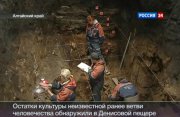 Anastasia has been drawing only bones and stones for 16 years. It is not a new art trend, but her work - to document work tools of ancient humans in the smallest fine detail.
Anastasia has been drawing only bones and stones for 16 years. It is not a new art trend, but her work - to document work tools of ancient humans in the smallest fine detail.
"The direction of the marks on this material is not always visible, especially on a photograph, but an artist can show it with use of shading and cross-hatching, that is - an archeologist can see it right away", - explains Anastasia Abdulmanova, an artist of Institute of Archeology and Ethnography of Siberian section of RAN.
All these finds were made in Denis's Cave. Evidence of the last 280 thousand years of life on Earth is hiding here. Each and every one of the numbered strata holds evidence of various civilizations. In the 11th stratum, archeologists found remains of heretofore unknown branch of humanity - the Denisovets.
"This is what happened. They were digging and an interesting bone popped up. They looked at it - the paleontologists here are famous - they showed it around, described it, and sent it to Germany. And the bone began to travel around and became famous", - says Alexander Sabankov, Senior scientist from Institute of Archeology and Ethnography of Siberian section of RAN.
The sensational find was made by archeologist Alexander Sabankov. He found a little child's finger bone in the 11th stratum - next to beads, rings and work tools. Until now it has been believed that such objects were associated only with Homo sapiens. The "thinking man" has been wandering around the earth 40 thousand years ago. But the Altai find turned out to be much older.
Svante Paabo, well known in scientific circles, performed a genetic analysis and confirmed: DNA of the child found in Denis's Cave did not belong either to Homo sapiens or to the Neanderthals.
"We can get information from a tiny piece of finger bone, and reconstruct the entire genome of an ancient human, we can tell about the evolution of a population", - Svante Paabo, professor of Leipzig's Max Planck Institute of Evolutionary Anthropology(Germany) is confident.
The chief archeologist of Siberia, Anatoly Derevyanko, brought the best paleogeneticists of Europe and America to Denis's Cave. Just the fact alone that such tools were not made by Homo sapiens forced scientists to take a brand new look at the entire history of our origins.
"There were four regions where humans evolved and where their material culture developed - Africa, Europe, Asia and Altai", - that is the opinion of Anatoly Derevyanko, Director of Institute of Archeology and Ethnography of Siberian section of RAN.
Archeologists continue their work in the cave. They cannot rule out that quite a few discoveries are waiting for them here.

